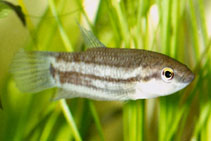| Family: |
Osphronemidae (Gouramies), subfamily: Macropodusinae |
| Max. size: |
6.73 cm SL (male/unsexed) |
| Environment: |
benthopelagic; freshwater; pH range: 7.1 - 7.6; dH range: 5 - 12 |
| Distribution: |
Asia: Malaysia, Singapore and Indonesia. |
| Diagnosis: |
Dorsal spines (total): 0-2; Dorsal soft rays (total): 7-10; Anal spines: 1-2; Anal soft rays: 24-26; Vertebrae: 28-31. A member of the Betta pugnax species group that can be differentiated from other members by the following combination of characters: presence of chin-bar; absence of dark marks below postorbital stripe on opercle; presence of dorsal transverse bars; caudal transverse bars present only in male; greenish to bluish iridescent scales on opercle and body; red subdistal band and black edge on anal fin; absence of dark edge on caudal fin; anal fin rays 25-28 (mode 26); lateral scales 28-31 (mode 29); postdorsal scales 11-12 (mode 11); pelvic fin length 26.6-43.8% SL; head length 27.5-35.2% SL; inter-orbital width 32.4-53.0% HL (Ref. 56613). |
| Biology: |
Occurs in small fast flowing forest streams (Ref. 13061). Inhabits mainly overhanging bank vegetation, submerged leaf litter and exposed roots of bank vegetation (Ref. 13220, 56613). Mouth brooder (Ref. 13061). |
| IUCN Red List Status: |
Least Concern (LC); Date assessed: 18 January 2019 Ref. (130435)
|
| Threat to humans: |
harmless |
Source and more info: www.fishbase.org. For personal, classroom, and other internal use only. Not for publication.

